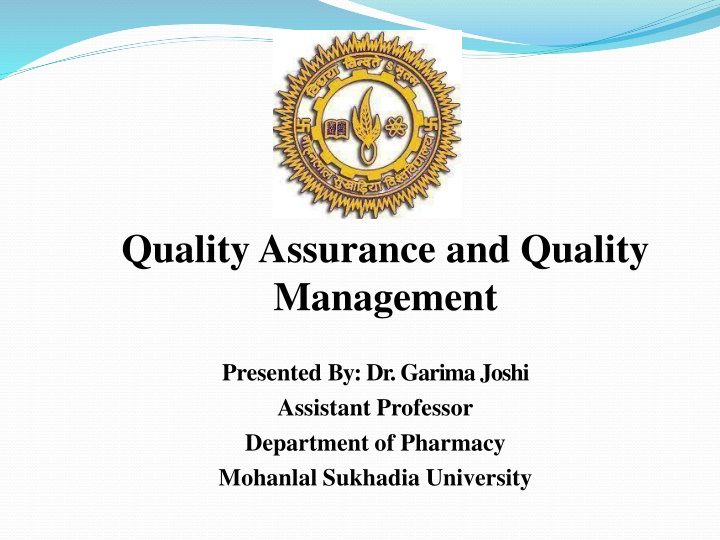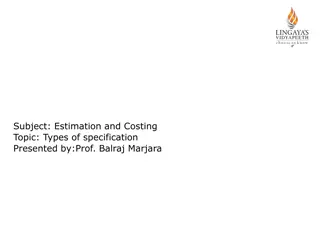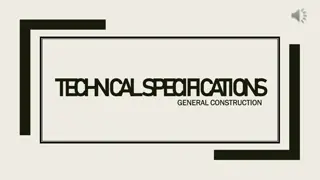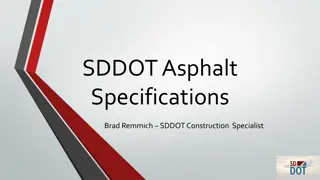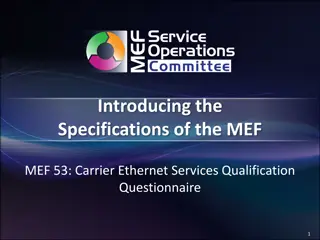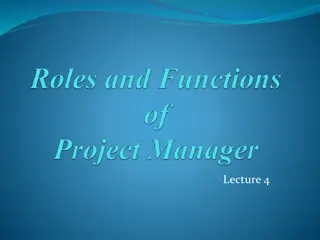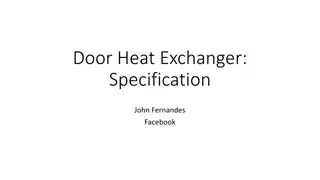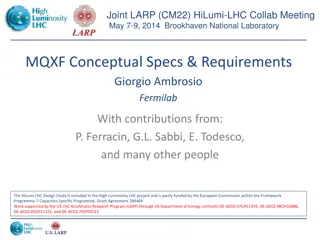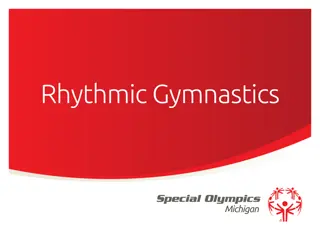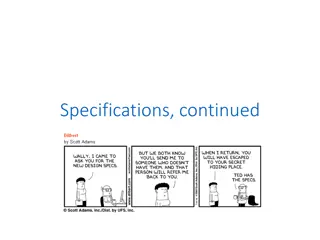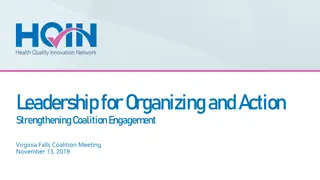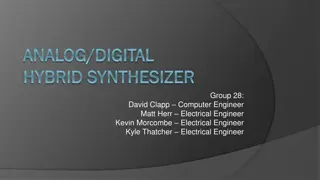Guide to Organizing Project Specifications
Specifications are written requirements essential for architectural projects. They encompass details on the quality, fabrication, installation, and workmanship required. Including necessary codes, standards, and provisions for alternative materials is crucial. Project manuals, which contain bidding and construction requirements, are structured to aid practitioners in adhering to the specifications effectively.
Download Presentation

Please find below an Image/Link to download the presentation.
The content on the website is provided AS IS for your information and personal use only. It may not be sold, licensed, or shared on other websites without obtaining consent from the author.If you encounter any issues during the download, it is possible that the publisher has removed the file from their server.
You are allowed to download the files provided on this website for personal or commercial use, subject to the condition that they are used lawfully. All files are the property of their respective owners.
The content on the website is provided AS IS for your information and personal use only. It may not be sold, licensed, or shared on other websites without obtaining consent from the author.
E N D
Presentation Transcript
Quality Assurance and Quality Management Presented By: Dr. Garima Joshi Assistant Professor Department of Pharmacy Mohanlal Sukhadia University
What is Quality Assurance? Quality Assurance (QA) is a way of preventing mistakes or defects in manufactured products and avoiding problems when delivering solutions or services to customers. ISO 9000 defines quality assurance as "A part of quality management focused on providing confidence that quality requirements will be fulfilled Quality Assurance (QA) refers to the process used to create the deliverables, and can be performed by a manager, client, or even a third-party reviewer. Examples of quality assurance include process checklists, project audits and methodology and standards development.
What is Quality Control? Quality control (QC) is a process by which entities review the quality of all factors involved inproduction. ISO 9000 defines quality control as "A part of quality management focused on fulfilling qualityrequirements". Quality Control (QC) refers to quality related activities associated with the creation of project deliverables. Quality control is used to verify that deliverables are of acceptable quality and that they are complete and correct. Examples of quality control activities include inspection, deliverable peer reviews and the testingprocess.
Responsibilities in QualityAssurance & Quality Control The construction contractor will be responsible for the quality of construction in the finished product and for compliance with the construction documents, drawing and specifications. The Project Engineer will have ultimate responsibility for the oversight of construction and for conformance with the construction drawings, specifications, and quality assurance requirements. The QC team members will be employed by the construction contractor. Therefore, specific positions and their associated descriptions and responsibilities will be set forth by the contractor procured. However, the construction contract documents require that the contractor assign an individual to manage the QC team and that the individual will not be directly involved in supervising construction activities.
Construction QualityAssurance Team/Authorities The QA team will solely participate in the quality assurance function and will not be involved in any other aspect of the construction effort. This team will however possess all of the credentials, capabilities and experience of independent design/construction oversight team. The duties and responsibilities of each position are described below. One individual or entity may perform multiple QA responsibilities
QA- Responsibilities Project Engineer - The Project Engineer is responsible for overall implementation and management of the QA/QC Plan and will supervise the preparation of the construction certification report. The Project Engineer will be independent of the construction contractor, but directly accountable to LSS for the successful completion of the work. The duties and responsibilities of the Project Engineer include the following: Review and approve construction drawings. Provide support to the QA Manager in interpreting the meaning and intent of the construction plans and specifications and in the performance and supervision of the QAtestingprogram. Provide consultation and technical support to Legacy Site Services(LSS).
QA-Responsibilities QA Manager - The QA Manager will be assigned to the site on a full-time basis, and will report directly to the Project Engineer. The duties and responsibilities of the QA Manager include the following: Coordinate QA activities with the Construction Manager and the Project Engineer. Review contractor invoices and recommend payment schedule to the Project Engineer. Maintain copies of all QA and QC testing results and certifications. Prepare and distribute weekly construction reports to the Project Engineer and LSS. Provide input on the construction certification report.
QA-Responsibilities Geotechnical QA Manager - The Geotechnical QA Manager will be on site during all earthwork operations requiring quality assurance testing, including excavation and site preparation, and construction of the Groundwater barrier wall (GWBW) and cap. They will oversee the activities of the Field QA Inspectors and coordinate the testing programs of the QALaboratory. QA Laboratory - The QA Laboratory will be an entity independent of both LSS and the construction contractor, located either on site or off site. It will be responsible for conducting tests on soil materials and soil-reagent mixes to ensure conformance with the contract plans and specifications. The QA Laboratory will not analyze soils or soil-reagent mixes provided by any party involved with the supply of materials, the construction contractor, or subcontractors. The QALaboratory will report directly to the QAManager.
QA-Responsibilities Field QA Inspectors - Field QA Inspectors will report directly to the QA Manager and will be present during all major construction activities. The duties and responsibilities of this position include the following: Visually inspect materials imported to the site for conformance with contract specifications and for variations from tests completed prior to the materials being delivered to the site. Obtain samples for geotechnical QAtesting. Observe field sampling and testing performed by the contractor's QC staff, and review test results. Observe and record observations regarding the storage and handling of equipment and materials.
QUALITY MANAGEMENT Introduction to QM Quality management can be defined as the process that includes all activities of the performing organization that determines the quality policies, objectives and responsibilities so that the project will satisfy the need for which it has been undertaken.
QUALITY MANAGEMENT SYSTEM Quality management system (QMS) is a formalized system that document, procedures and responsibilities for achieving quality polices and objectives. It helps coordinate and direct an organization s activities to meet customer and regulatory requirement and improve its effectiveness and efficiency on a continuous basis. It serves many purposes including: IMPROVING PROCESSES REDUCING WASTE LOWERING COST ENGAGGING STAFF SETTING ORGANIZATION- WIDE DIRECTION
THE RISE OF QUALITY MANAGEMENT SYSTEM:- The American response to the quality revolution in Japan gave birth to the concept of total quality management (TQM), a method for quality management that emphasized not only statistics but approaches that embraced the entire organization. In the late 20th century, independent organizations began producing standards to assist in the creation and implementation of quality management systems. It is around this time that the phrase Total Quality Management began to fall out of favour. Because of the multitude of unique systems that can be applied, the term Quality Management System or QMS is preferred. At the start of the 21st century, QMS had begun to merge with the ideas of sustainability, and transparency, as these themes became increasingly important to consumer satisfaction. The ISO 19011 audit regime deals with both quality and sustainability and their integration intoorganizations.
ISO 9000 FAMILY:- ISO 9000 is a set of international standards on quality management and quality assurance developed to help companies effectively document the quality system elements to be implemented to maintain an efficient quality system. They are not specific to any one industry and can be applied to organizations of any size. ISO 9000 can help a company satisfy its customers, meet regulatory requirements, and achieve continual improvement. However, it should be considered to be a first step, the base level of a quality system, not a complete guarantee of quality.
STANDARDS IN THE ISO 9000 FAMILYINCLUDE: ISO 9001:2015- SETS OUT THE REQUIREMENTS OF A QUALITY MANAGEMENT SYSTEM ISO 9000:2015 - COVERS THE BASIC CONCEPTS AND LANGUAGE ISO 9004:2009 - FOCUSES ON HOW TO MAKE A QUALITY MANAGEMENT SYSTEM MORE EFFICIENT AND EFFECTIVE ISO 19011:2011- SETS OUT GUIDANCE ON INTERNAL AND EXTERNAL AUDITS OF QUALITY MANAGEMENT SYSTEMS
BENEFITS OF QUALITY MANAGEMENT SYSTEM:- Implementing a quality management system affects every aspect of an organization's performance. Two overarching benefits to the design and implementation of documented quality management systems include: 1. Meeting the customer s requirements, which helps to instil confidence in the organization, in turn leading to more customers, more sales, and more repeat business 2. Meeting the organization's compliance with regulations and provision of products and services in the most cost- and resource- creating room for expansion, growth, andprofit requirements, which ensures efficient manner,
Good Manufacturing Practice What is GMP? Good Manufacturing codes, and substances and drug products, medical devices, in vivo and in vitro diagnostic products, and foods. Practice is a set of guidelines for the regulations, manufacture of drug
OBJECTIVE Guaranteed high quality products to the consumer. Delivering products free of all possible contamination
GENERALREQUIREMENTS Avoid risks and possibilities of mix-up at all stages of Mfg, labeling, Pkg and testing. AHUs, comfort of the personnel working monitoring of temp & humidity, Particle Count, DOP testing etc. Proper drainage system which prevents backflow. Avoid open channels and if provided must be able disinfectant and regular to clean and
Good manufacturing Practice A basic principle of GMP is that quality cannot be tested into a batch of product but must be built into each batch of product during all stages of the manufacturing process. It is designed to minimize the risks involved in any pharmaceutical production that cannot be through testing the final product. eliminated
Ten Principles of GMP Design and construct the facilities and equipments properly Follow written procedures and Instructions Document work Validate work Monitor facilities andequipment Write step by step operating procedures and work on instructions Design ,develop and demonstrate job competence Protect againstcontamination Control components and product relatedprocesses 10. Conduct planned and periodic audits 1. 2. 3. 4. 5. 6. 7. 8. 9.
GMP CATEGORIES Packaging Testing Finished Product Testing Quality Control Department Records Samples Stability Sterile Products Material Sale Premises Equipment Personnel Sanitation Raw Material Testing Manufacturing Control
Sale No distributor and no importer shall sell a drug unless it has been fabricated, packaged/labeled, tested, and stored. Premises & Equipment Permits effectivecleaning Prevents contamination Orderly conditions Good state ofrepair
Personnel Appropriate education, training and experience Sufficient numberof people Receive GMPtraining Sanitation Sanitation Program to prevent contamination Limit the sourcesand typesof contamination Cleaning procedures for facilities& equipment Pest control Environmental monitoring
Raw Material, Packaging Material and Finished Product Testing each lot or batch of raw material is tested confirm the identity of the raw materials provide assurance that quality of the drug in dosage Samples of incoming materials are collected and tested before use Approved test methods and specifications are used Results must conform to specifications for release for use orsale Transportation andstorage records
Why GMP is important Apoor quality medicine may contain toxic substances that have been unintentionally added. A medicine that contains little or none of the claimed ingredient will not have the intended therapeutic effect. Some of the main risks are . unexpected contamination of products, causing damage to health or even death. incorrect labels on containers, which could mean that patients receive the wrong medicine. insufficient or too much active ingredient, resulting in ineffective treatment or adverse effects.
